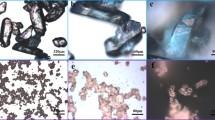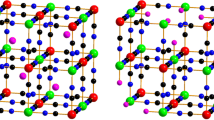Abstract
The thermal dehydration and decomposition of copper(II) phthalate monohydrate was studied by isothermal and non-isothermal methods. The decomposition process consisted of three steps: two steps of dehydration and the third of decomposition. The kinetics of isothermal dehydration reactions follow (i) a unimolecular law up to the formation of copper(II) phthalate hemihydrate, and (ii) a phase boundary model giving anhydrous copper(II) phthalate, while the kinetics of isothermal decomposition reaction comply with the Erofeev-Avrami equation, [−ln(1−α)]1/n=Kt+C. The energies of activation for the formation of the decomposition products were calculated. The decomposition products were characterized by elemental analysis, photomicrographic observations, infrared and reflectance spectra and X-ray powder diffraction data.
Résumé
On a étudié, par des méthodes isothermes et non-isothermes, la déshydratation et la décomposition thermique du phtalate de cuivre(II) monohydraté. Le procèssus de décomposition consiste en trois étapes: deux étapes de déshydratation et la troisième de décomposition. La cinétique des réactions de déshydratation isotherme suit (i) une loi unimoléculaire jusqu'à la formation de phtalate de cuivre(II) hémihydraté, et (ii) un modèle de surfaces limites qui donne du phtalate de cuivre(II) anhydre, tandis que la cinétique de la réaction de décomposition isotherme satisfait l'équation d'Eroféev-Avrami: [−ln(1−α)]1/n=Kt+C. On a calculé les énergies d'activation de la formation des produits de décomposition. On a caractérisé les produits de décomposition par analyse élementaire, par des observations micrographiques, des spectres infrarouges et d'émission ainsi que par des données de diffraction sur poudre des rayons X.
Zusammenfassung
Die thermische Dehydratisierung und Zersetzung von Kupfer(II)Phthalat Monohydrat wurde durch isotherme und nichtisotherme Methoden untersucht. Der Zersetzungsvorgang bestand aus drei Stufen: zwei Stufen der Dehydratisierung und die dritte der Zersetzung. Die Kinetik der isothermen Dehydratisierungsreaktionen folgt (i) einem unimolekularen Gesetz bis zur Bildung von Kupfer(II)Phthalat Hemihydrat und (ii) einem Grenzflächen modell, das wasserfreies Kupfer(II)Phthalat ergibt, während die Kinetik der isothermen Zersetzungsreaktion der Erofeev-Avrami Gleichung, [−ln(1−α)]1/n=Kt+C genügt. Die Aktivierungsenergien für die Bildung der Zersetzungsprodukte wurden berechnet. Die Zersetzungsprodukte wurden durch Elementaranalyse, mikrophotographische Beobachtungen, Infrarot- und Remissionsspektra sowie Röntgen-Pulverdiffraktionsdaten charakterisiert.
Резюме
С помощью изотермиче ского и неизотермического м етодов анализа были изучены термическая дегидратация и разло жение моногидрата фталата меди(II). Процесс разложения протекае т в три стадии: две стад ии дегидратации и треть ей стадии разложения. Кинетика реакций изо термической дегидра тации подчиняется мономол екулярному закону до образовани я полугидрата фталат а меди(II) и модели фазовой грани цы, давая безводный фталат мед и(II). Кинетика реакции изотермического раз ложения подчиняется уравнению Ерофеева-А врами: [-In(1-α)]1/n=Kt+С. Вычислен ы энергии активации об разования продуктов разложени я. Продукты разложени я были охарактеризованы эл ементарным анализом, фотомикрог рафией, ИК спектрами и спектрами отражения, а также порошковой рентгено графией.
Similar content being viewed by others
References
M. J. McGinn, B. R. Wheeler andA. K. Galwey, Trans. Faraday Soc., 67 (1971) 1.
H. Yokobayashi, K. Nagase andK. Muraishi, Bull. Chem. Soc., Japan, 48 (1975) 2789.
P. S. Bassi andP. C. Kalsi, Ind. J. Chem., Ser. A, 14 (1976) 967.
P. S. Bassi andP. C. Kalsi, J. Thermal Anal., 10 (1976) 375.
P. S. Bassi andP. C. Kalsi, J. Thermal Anal., 13 (1978) 363.
C. K. Prout, J. R. Carruthers andF. J. C. Rossotti, J. Chem. Soc., Ser. A, (1971) 3350.
A. I. Vogel, Quantitative Inorganic Analysis, Longmans, Green and Co., London, p. 497 1962.
P. S. Bassi, P. C. Kalsi andC. M. Khajuria, Ind. J. Chem., Ser. A, 15 (1977) 399.
D. M. Speros andH. R. Werner, Analytical Calorimetry, (ed. R. R. Porter J. F. Johnson), Plenum Press, New York, Vol. 3 p. 511 1974.
K. Nakamoto, Infrared Spectra of Inorganic and Co-ordinated compounds (John Wiley and Sons, Inc. London), p. 155 1962.
M. Avrami, J. Chem. Phys., 9 (1941) 177.
B. V. Erofeev, Compt. Rend. Acad. Sci. (U.R.S.S.), 52 (1946) 54.
H. E. Swanson andE. Tatge, NBS Circular 539 Vol. I (1953) 49.
H. E. Swanson andR. K. Fuyat, NBS Circular 539 vol. II (1953) 23.
Author information
Authors and Affiliations
Additional information
One of the authors (C. M. K.) is grateful to the University of Jammu, Jammu, for the award of a Fellowship.
Rights and permissions
About this article
Cite this article
Bassi, P.S., Kalsi, P.C. & Khajuria, C.M. Thermal decomposition of copper(II)phthalate monohydrate. Journal of Thermal Analysis 18, 77–85 (1980). https://doi.org/10.1007/BF01909455
Received:
Issue Date:
DOI: https://doi.org/10.1007/BF01909455




